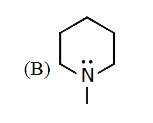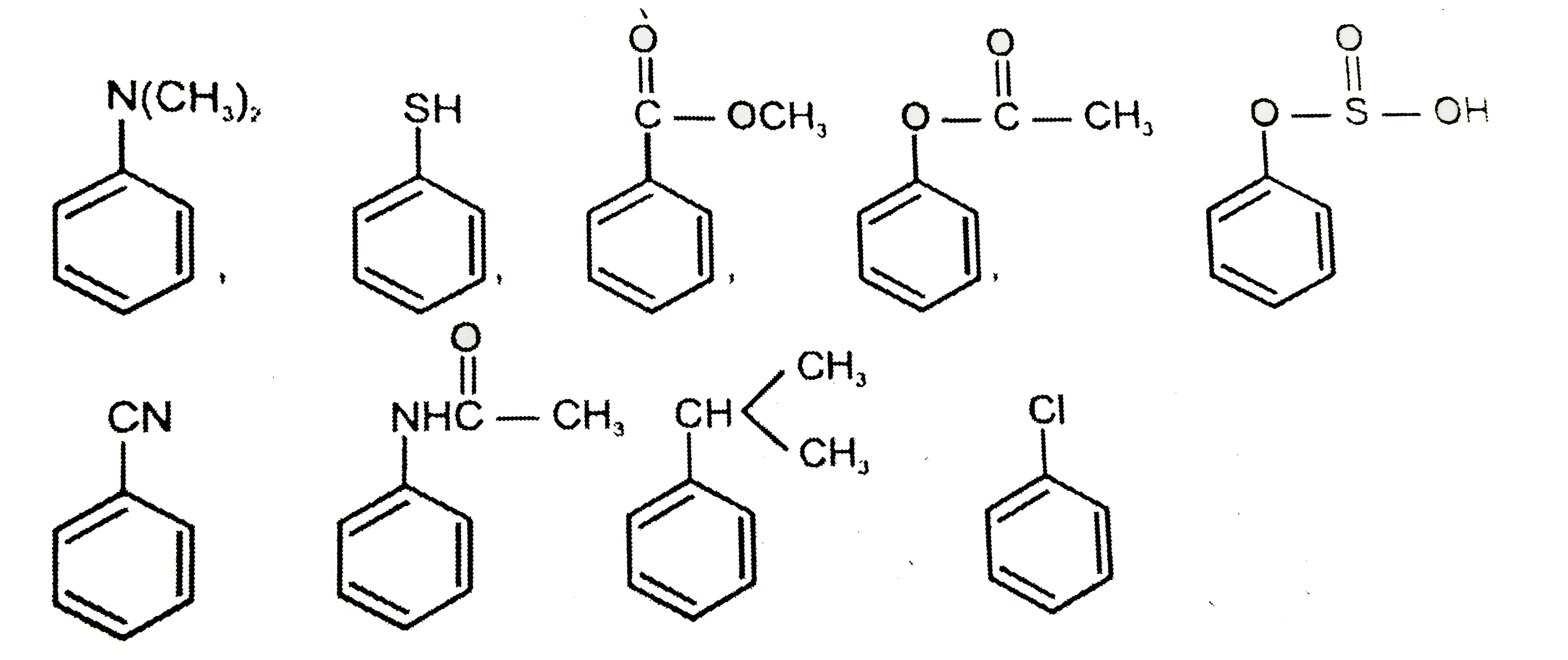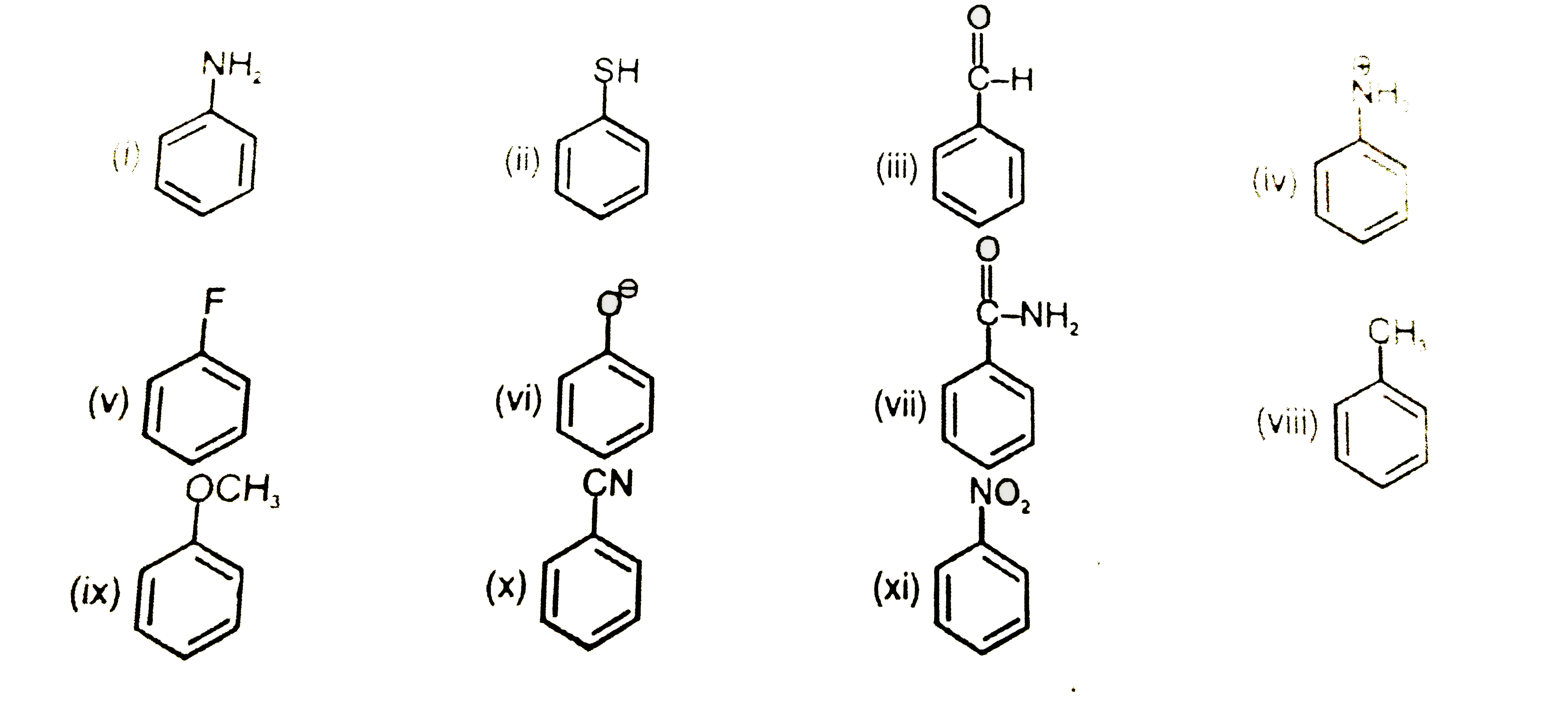In which of the following, the group attached to the benzene ring shows +R effect



All of these
To determine which groups attached to a benzene ring show the +R (positive resonance) effect, we need to analyze the groups in question. The +R effect occurs when a substituent on the benzene ring donates electron density to the ring through resonance, thus increasing the electron density of the ring.
1. Understanding the +R Effect:
- The +R effect is associated with groups that can donate electron density to the benzene ring. This typically involves groups that have lone pairs of electrons or π-electrons that can participate in resonance.
2. Identifying the Groups:
- Let's consider the common groups that are known to show the +R effect:
- Hydroxyl group (-OH)
- Amino group (-NH2)
- Methoxy group (-OCH3)
3. Analyzing Each Group:
- Hydroxyl Group (-OH):
- The oxygen atom has a lone pair of electrons that can be delocalized into the benzene ring. This increases the electron density of the ring, thus showing the +R effect.
- Resonance structure: The lone pair on oxygen can form a double bond with the benzene ring, creating a negative charge on the oxygen and increasing electron density on the ring.
- Amino Group (-NH2):
- Similar to the hydroxyl group, the nitrogen in the amino group has a lone pair of electrons that can be delocalized into the benzene ring, increasing the electron density.
- Resonance structure: The lone pair on nitrogen can also form a double bond with the benzene ring, leading to a resonance structure that increases the electron density.
- Methoxy Group (-OCH3):
- The oxygen in the methoxy group has a lone pair that can be donated to the benzene ring, thus increasing the electron density.
- Resonance structure: The lone pair on oxygen can participate in resonance with the benzene ring, similar to the -OH and -NH2 groups.
4. Conclusion:
- All three groups (-OH, -NH2, -OCH3) show the +R effect as they all donate electron density to the benzene ring through resonance.
- Therefore, the correct answer is that all of these groups exhibit the +R effect.
Final Answer:
All of the groups attached to the benzene ring show the +R effect.
- The +R effect is associated with groups that can donate electron density to the benzene ring. This typically involves groups that have lone pairs of electrons or π-electrons that can participate in resonance.
- Let's consider the common groups that are known to show the +R effect:
- Hydroxyl group (-OH)
- Amino group (-NH2)
- Methoxy group (-OCH3)
- Hydroxyl Group (-OH):
- The oxygen atom has a lone pair of electrons that can be delocalized into the benzene ring. This increases the electron density of the ring, thus showing the +R effect.
- Resonance structure: The lone pair on oxygen can form a double bond with the benzene ring, creating a negative charge on the oxygen and increasing electron density on the ring.
- Similar to the hydroxyl group, the nitrogen in the amino group has a lone pair of electrons that can be delocalized into the benzene ring, increasing the electron density.
- Resonance structure: The lone pair on nitrogen can also form a double bond with the benzene ring, leading to a resonance structure that increases the electron density.
- The oxygen in the methoxy group has a lone pair that can be donated to the benzene ring, thus increasing the electron density.
- Resonance structure: The lone pair on oxygen can participate in resonance with the benzene ring, similar to the -OH and -NH2 groups.
- All three groups (-OH, -NH2, -OCH3) show the +R effect as they all donate electron density to the benzene ring through resonance.
- Therefore, the correct answer is that all of these groups exhibit the +R effect.
All of the groups attached to the benzene ring show the +R effect.
Topper's Solved these Questions
- ORGANIC CHEMISTRY : SOME BASIC PRINCIPLES AND TECHNIQUES BOOK - AAKASH INSTITUTECHAPTER - ORGANIC CHEMISTRY : SOME BASIC PRINCIPLES AND TECHNIQUES EXERCISE - Assignment(SECTION-A)
60 Videos
- ORGANIC CHEMISTRY : SOME BASIC PRINCIPLES AND TECHNIQUES BOOK - AAKASH INSTITUTECHAPTER - ORGANIC CHEMISTRY : SOME BASIC PRINCIPLES AND TECHNIQUES EXERCISE - Assignment(SECTION B)
3 Videos
- ORGANIC CHEMISTRY : SOME BASIC PRINCIPLES AND TECHNIQUES BOOK - AAKASH INSTITUTECHAPTER - ORGANIC CHEMISTRY : SOME BASIC PRINCIPLES AND TECHNIQUES EXERCISE - Try Yourself
23 Videos
- MOCK_TEST_20BOOK - AAKASH INSTITUTECHAPTER - MOCK_TEST_20EXERCISE - EXAMPLE
28 Videos
- ORGANIC CHEMISTRY: SOME BASIC PRINCIPLE AND TECHNIQUESBOOK - AAKASH INSTITUTECHAPTER - ORGANIC CHEMISTRY: SOME BASIC PRINCIPLE AND TECHNIQUESEXERCISE - TRY YOURSELF
28 Videos
Similar Questions
Knowledge Check
Which of the following froups groups deactivates the benzene ring towards electrophilic substitution ?
A−NHRB−OHC−COORD−ORWhich of the following group activates the benzene ring most towards electrophilic substitution
A−CHOB−NR2C−NHCOCH3D−NO2Which of the following group(s) activate the benzene ring towards electrophilic substitution reaction.
A−ClB C−O−O||C−CH3D−C≡..N
C−O−O||C−CH3D−C≡..N
Which of the following group show −m effect?
View SolutionWhich of the following does not contain fused benzene rings ?
View SolutionWhich of the following group show +Meffect ?
View SolutionThe halogen atom attached to C-atom in the benzene ring is:
View SolutionWhich of the following group shows +l− effect :
View Solution


